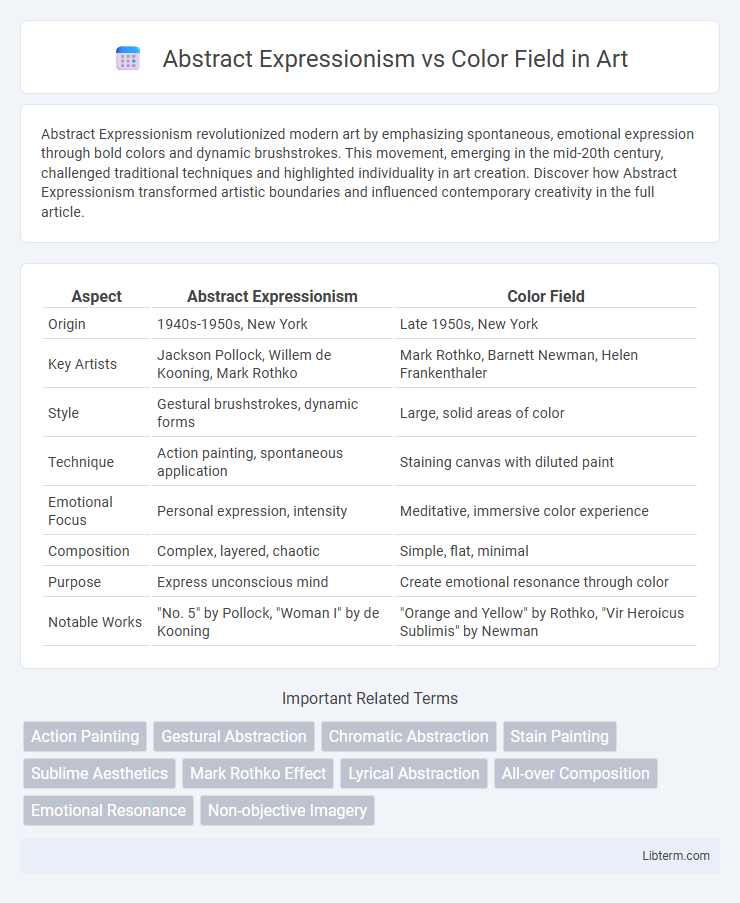Abstract Expressionism revolutionized modern art by emphasizing spontaneous, emotional expression through bold colors and dynamic brushstrokes. This movement, emerging in the mid-20th century, challenged traditional techniques and highlighted individuality in art creation. Discover how Abstract Expressionism transformed artistic boundaries and influenced contemporary creativity in the full article.
Table of Comparison
| Aspect | Abstract Expressionism | Color Field |
|---|---|---|
| Origin | 1940s-1950s, New York | Late 1950s, New York |
| Key Artists | Jackson Pollock, Willem de Kooning, Mark Rothko | Mark Rothko, Barnett Newman, Helen Frankenthaler |
| Style | Gestural brushstrokes, dynamic forms | Large, solid areas of color |
| Technique | Action painting, spontaneous application | Staining canvas with diluted paint |
| Emotional Focus | Personal expression, intensity | Meditative, immersive color experience |
| Composition | Complex, layered, chaotic | Simple, flat, minimal |
| Purpose | Express unconscious mind | Create emotional resonance through color |
| Notable Works | "No. 5" by Pollock, "Woman I" by de Kooning | "Orange and Yellow" by Rothko, "Vir Heroicus Sublimis" by Newman |
Introduction to Abstract Expressionism and Color Field
Abstract Expressionism emerged in the 1940s as a pioneering art movement characterized by spontaneous, dynamic brushstrokes and emotional intensity, driven by artists like Jackson Pollock and Willem de Kooning. Color Field painting, a subset of Abstract Expressionism, developed in the 1950s emphasizes large expanses of uniform color and simplicity, with notable figures such as Mark Rothko and Barnett Newman. Both movements revolutionized post-war American art by shifting focus from representational forms to abstract, expressive content that evokes individual viewer response.
Historical Context and Origins
Emerging in the post-World War II era, Abstract Expressionism originated in the 1940s New York art scene, emphasizing spontaneous, emotional intensity and the artist's gesture. Color Field painting, developing in the late 1950s, evolved as a subset of Abstract Expressionism but shifted focus toward large areas of solid color to evoke contemplative moods. Both movements responded to the trauma and existential uncertainty of their time, reflecting shifts in American cultural dominance and the search for new artistic languages.
Key Philosophies and Artistic Intentions
Abstract Expressionism emphasizes spontaneous, dynamic brushwork and emotional intensity to convey the artist's inner psyche, aiming for a direct, personal connection with the viewer. Color Field painting focuses on large, flat areas of color to evoke a contemplative, immersive experience, prioritizing simplicity and the emotional resonance of color itself. Both movements seek to transcend representational art but differ in their approach: Abstract Expressionism is about expressive gesture and angst, while Color Field centers on meditation and color's abstract purity.
Influential Artists from Both Movements
Abstract Expressionism, influenced by artists like Jackson Pollock and Willem de Kooning, emphasizes spontaneous, gestural brushwork and emotional intensity. Color Field painting, represented by Mark Rothko and Barnett Newman, focuses on large fields of flat, solid color to evoke contemplative responses. Both movements shaped mid-20th-century American art by redefining abstraction through distinct yet complementary approaches.
Visual Characteristics and Techniques
Abstract Expressionism features dynamic brushstrokes, intense textures, and spontaneous gestures creating emotional intensity and motion. Color Field painting emphasizes large, flat areas of solid color, smooth surfaces, and subtle tonal variations to evoke meditative or lyrical feelings. Techniques in Abstract Expressionism often include action painting and impasto, while Color Field artists use staining or thin washes of diluted paint to achieve uniform color expanses.
Use of Color and Space
Abstract Expressionism employs bold, dynamic colors and vigorous brushstrokes to convey intense emotion and movement, often filling the canvas with energetic compositions. In contrast, Color Field painting emphasizes large, flat expanses of color that create a meditative space, using subtle variations in hue and tone to evoke depth and atmosphere. While Abstract Expressionism focuses on spontaneity and gestural marks, Color Field prioritizes color as the primary vehicle for spatial perception and emotional resonance.
Emotional Impact and Viewer Experience
Abstract Expressionism emphasizes intense emotional expression through dynamic brushstrokes and bold contrasts, creating a visceral, immersive experience for the viewer. Color Field painting, characterized by expansive areas of solid color and subtle tonal variations, fosters a meditative and contemplative atmosphere that invites introspection. Both movements engage the viewer emotionally but differ by Abstract Expressionism's energetic, chaotic intensity versus Color Field's calm, harmonious presence.
Critical Reception and Art World Influence
Abstract Expressionism received critical acclaim for its emotionally charged gestural brushstrokes and individualistic approach, profoundly influencing post-war American art with figures like Jackson Pollock and Willem de Kooning. Color Field painting, characterized by large expanses of solid color exemplified by artists such as Mark Rothko and Barnett Newman, was initially seen as a more meditative and contemplative evolution, garnering praise for its focus on color's emotional resonance. Both movements reshaped the art world by shifting attention from European to American artists, fostering innovations that emphasized spontaneity and pure color over representational forms.
Lasting Legacy in Modern Art
Abstract Expressionism's lasting legacy in modern art is its emphasis on spontaneous, gestural brushstrokes that convey intense emotion and individual expression, shaping the trajectory of postwar American art. Color Field painting, characterized by large areas of flat, solid color and simplicity, influenced minimalism and conceptual art by prioritizing color and form over narrative content. Both movements challenged traditional representation, paving the way for diverse contemporary practices that explore abstraction and emotional depth.
Conclusion: Comparing Impact and Meaning
Abstract Expressionism revolutionized art through dynamic brushstrokes and emotional intensity, emphasizing individual expression and spontaneity. In contrast, Color Field painting prioritized large, flat areas of color to evoke contemplation and subconscious response, focusing on color's meditative qualities. Both movements significantly influenced modern art by expanding the boundaries of abstraction and redefining the viewer's emotional and perceptual engagement with painting.
Abstract Expressionism Infographic

 libterm.com
libterm.com